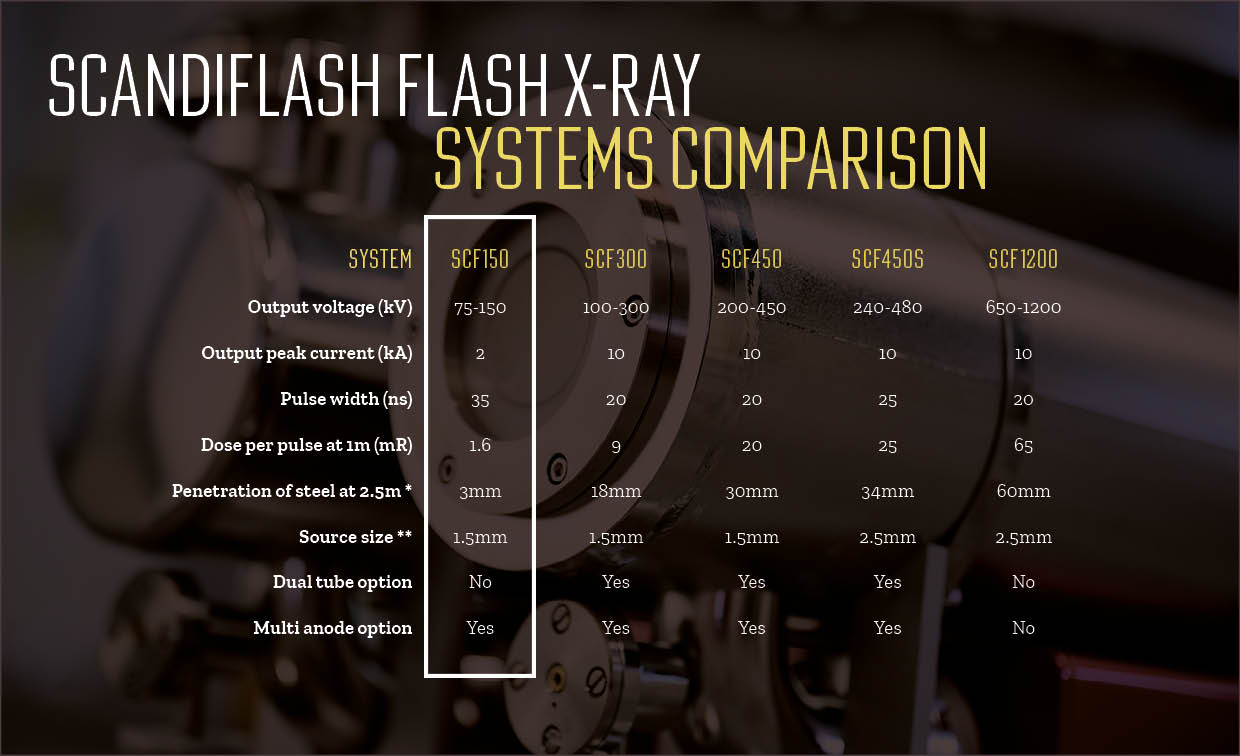See through smoke and fire with our SCF150 low-energy-level system
The 150 system is ideal for research involving both shadow imaging and penetrating soft materials like plastic or tissue as well as thin metal plates like aluminum and steel.
The 150 is a versatile system that can be used for everything form granular mechanics to forensic science studies, and you can use this system both indoors and outdoors.
An adjustable low-energy-level system to match your needs
Each Scandiflash system offers the option to fine tune the energy output level to match your needs within a specified range. The 150 is our low-energy-level system.
The 150 generates a broad band energy spectrum with a maximum intensity located at an energy about 1/3 of the maximum energy output. Since we’re able to vary the total energy output between 75 and 150 keV, that means we can fine tune our intensity maxima to be in the order of 25 to 50 keV. And that’s ideal for capturing X-ray images of objects contained in soft materials like plastic, tissue or thin metal plates like aluminum and steel.
The 150 is also perfect for imaging through smoke and fire.
Trigger certainty
When tuning the energy of your system the pressure of the Marx generator Pulser also needs to be regulated to prevent un-wanted discharge events. Users of Scandiflash Flash X-ray systems don’t worry about “pre-fire” or “no trigger” errors.
We’ve accomplished this by designing our systems to automatically set the correct pressure required for a selected voltage in our Marx Generator Pulsers. No complicated tabulation and testing of parameters – simply select the voltage desired, and our system optimizes for each X-ray pulse. Experiments can be completed more reliably and stay on schedule!
What application area do you need to explore?
We’ve seen new application areas being explored and tested with the 150 system. One fascinating area where the 150 performs extremely well happens when we tune the total energy output to 90 keV and we get an energy maxima of approximately 30 keV. This is similar to the energies of many imaging beam lines. And that makes the SCF150 system a perfect testbed for synchrotron and free electron laser simulated flashes.
Standards your research can rely on
The system is CE marked and includes safety features like overpressure valves and pressure readers. In addition to training and installation, we also offer optional equipment like X-ray shielding and emergency shut-offs.
The SCF150 system has 6 core components:
– PG150 Marx generator pulser
– XT150 X-ray tube
– control tower
– Scandicontrol software
– RPS 30 service station
– CAD 70 for pressure regulation which uses compressed dry air rather than hazardous SF6
The SCF150 system specifications
– variable output voltage ranging from 75-100 kV
– output peak current is 2kA
– 35ns short pulse
– dose per pulse at 1m is 1.6 mR
– the SCF150 can penetrate 3mm of steel at a distance of 2.5m
– the user can select between a 1, 2.5, and 4mm spot size
– supports our multi-anode option
We’re here to help you
Choosing Scandiflash means you get a flash X-ray system that’s built to meet your needs both today and tomorrow as well as a team that’s ready to support you.
Want to know more about taking your research to the next level? We’re curious to hear what you can imagine doing and seeing with our technology, so get in touch with us through our website or just give us a call at +46 18 557510.
Researching dynamics?
Sometimes you only get one chance – make it count.About Scandiflash
For over 50 years, Scandiflash has been pioneering flash X-ray technology to help scientists and researchers around the globe to see the nearly impossible. Scandiflash Flash X-Ray Systems generate extremely short pulses used to capture dynamics in the harshest of conditions, ranging from indoor lab setups to outdoor large-scale firing ranges. The systems are modular and can be tailored to meet your requirements for number of pulses and peak energy conditions.


